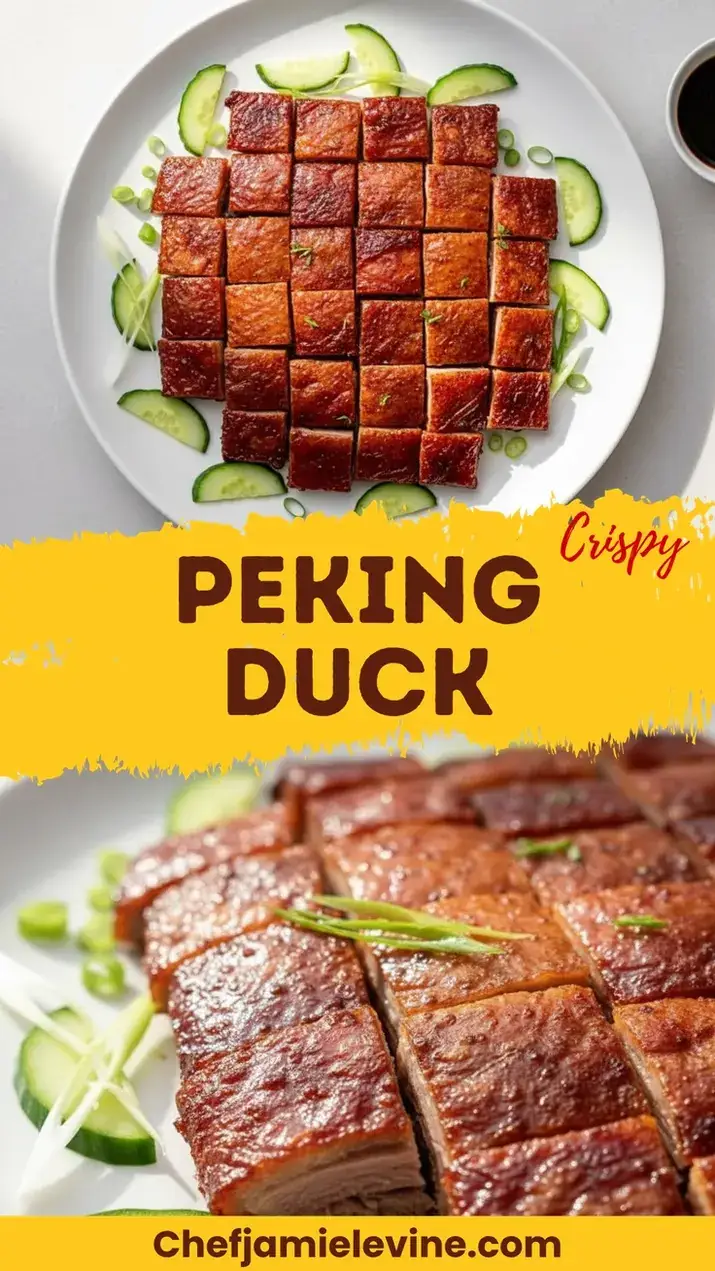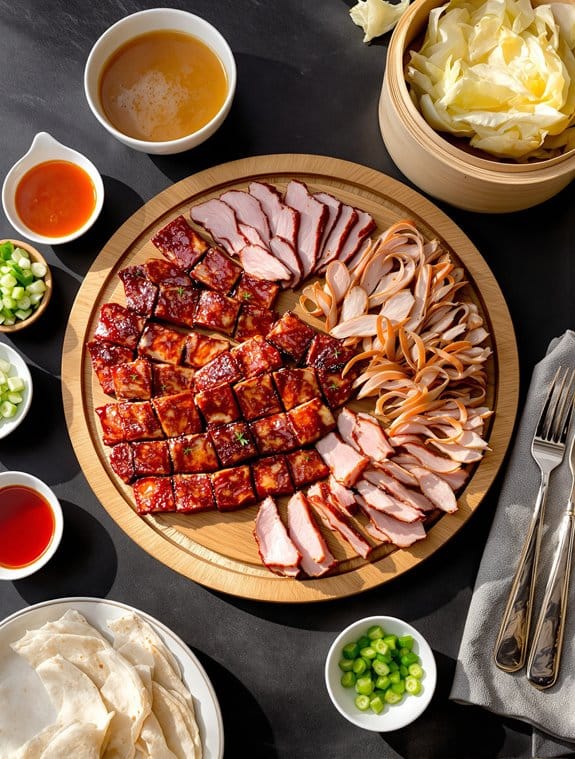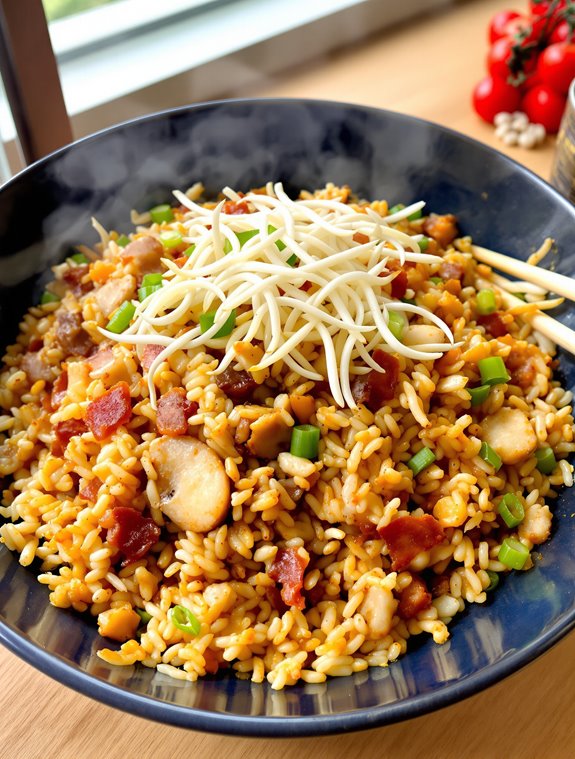Why You’ll Love this Crispy Peking Duck
This legendary Peking Duck recipe transforms your kitchen into a world-class Chinese restaurant, creating that magical combination of crackling crispy skin and tender, succulent meat that’s usually reserved for special occasions.
I’m obsessed with how the simple overnight air-drying method creates that signature crispy skin we all crave. The malt sugar and soy sauce mixture? It works like culinary magic, giving you that gorgeous lacquered finish.
And can we talk about the complete experience—those paper-thin pancakes, the sweet plum sauce, and the fresh cucumber and scallion garnishes? Pure theater on a plate. Trust me, your guests will wonder when you secretly trained as a Chinese chef.
What Ingredients are in Crispy Peking Duck?
To create an authentic Crispy Peking Duck at home, you’ll need a combination of traditional ingredients that work together to create that distinctive lacquered skin and juicy meat. While it might seem intimidating at first, the ingredient list is actually quite straightforward, focusing on simple components that transform through the cooking process into something extraordinary.
- 3-4 pounds whole duck
- 1 teaspoon malt sugar (resembles honey)
- 2 tablespoons soy sauce
- 1/2 cup plum sauce (for serving)
- 1/2 cup sweet red bean paste or hoisin sauce (for serving)
- 10 scallions, trimmed and quartered lengthwise
- 1 small cucumber, peeled and cut into thin strips about 2 inches long
- 2 cups flour (for pancakes)
- 1 cup boiling water (for pancakes)
- Vegetable oil or sesame oil (for cooking pancakes)
Most of these ingredients can be found in your regular grocery store, but you might need to visit an Asian market for the malt sugar, plum sauce, and sweet red bean paste. The malt sugar is essential for achieving that signature crispy, glossy skin, so try not to substitute it if possible.
And while the recipe suggests either sweet red bean paste or hoisin sauce, I find hoisin to be more readily available and familiar to most home cooks. The thin pancakes take a bit of practice to make, but they’re worth the effort for the complete Peking Duck experience.
How to Make this Crispy Peking Duck

Making authentic Peking Duck starts with proper preparation of the duck itself. Begin by thoroughly cleaning your 3-4 pound duck and placing it in a basin. Boil a large kettle of water and pour it over the duck, completely dousing it—this vital step helps tighten the skin, which will later create that signature crispiness.
Immediately dry the duck inside and out with paper towels, then hang it by the neck overnight in a well-ventilated area. This drying process allows the skin to develop that papery quality that’s essential for the perfect crackle.
The next day, prepare a simple glaze by dissolving 1 teaspoon of malt sugar in 2 tablespoons of soy sauce, then thoroughly rub this mixture all over the duck. Let this coating dry completely—patience is key here.
Once dry, place the duck on a wire rack set in a roasting pan and slide it into a preheated 375°F oven for a full hour. Remember, don’t open the oven door or baste the duck during cooking; that constant temperature is what transforms the skin into that gorgeous lacquered finish we’re after.
While the duck roasts, prepare the traditional thin pancakes by mixing 2 cups of flour with 1 cup of boiling water until just combined. After resting the dough for 20 minutes, form it into a roll, cut off small rounds, and roll each into paper-thin pancakes. Cook these in a lightly oiled skillet for about 1¼ minutes per side until they begin to bubble and curl slightly.
When serving, slice the crispy skin into squares and the meat into thin strips, arranging them on separate platters. Set out small dishes of plum sauce, hoisin or sweet bean paste, scallion strips, and cucumber for your guests to assemble their own little bundles of duck heaven.
And don’t throw away that duck carcass—traditionally, it’s boiled with cabbage to create a comforting soup that ends the meal.
Crispy Peking Duck Substitutions and Variations
While traditional Peking Duck requires specific ingredients, I’ve found several substitutions that work beautifully when you can’t locate the authentic components.
No malt sugar? Honey works perfectly. Can’t find plum sauce? Mix hoisin with a bit of plum jam. The sweet red bean paste can be entirely replaced with hoisin sauce, which is easier to find in regular grocery stores.
For the pancakes, regular flour tortillas can stand in when you’re short on time. Trust me, I’ve been there.
And cucumber? Try julienned jicama or even thinly sliced pear for a surprising twist that still provides that invigorating crunch.
What to Serve with Crispy Peking Duck
A perfectly prepared Peking duck deserves equally thoughtful accompaniments that complement its rich, complex flavors.
I always serve mine with the traditional thin pancakes, which are surprisingly simple to make from just flour and boiling water. These delicate wrappers cradle the crispy duck beautifully.
Don’t forget the essential condiments: hoisin or sweet bean sauce, thinly sliced scallions, and cucumber strips.
The contrasting textures and temperatures create magic in every bite.
For a complete meal, I add a light soup (sometimes made from the duck carcass), steamed rice, and stir-fried greens.
Trust me, your guests will be too busy assembling perfect little duck pancakes to notice you sneaking extra crispy skin.
Final Thoughts
After preparing this legendary dish countless times, I’ve learned that patience truly distinguishes a good Peking duck from an exceptional one. The overnight air-drying creates that signature crispy skin we all crave, something you simply can’t rush.
Remember, Peking duck isn’t just dinner—it’s an experience, a ritual worth savoring. The communal assembly of those delicate pancakes, the balance of sweet hoisin, crisp cucumber, and that gloriously lacquered duck skin? Pure magic.
Trust me, your guests will talk about this meal for years.
And that final soup from the carcass? Don’t skip it—waste not, want not.

Peking Duck
Ingredients
Equipment
Method
- Thoroughly clean the duck and place it in a basin.
- Boil a large kettle of water and pour it over the duck, completely dousing it. This helps tighten the skin for better crispiness.
- Immediately dry the duck inside and out with paper towels.
- Hang the duck by the neck in a well-ventilated area overnight. This drying process is essential for developing the papery quality needed for crispy skin.
- The next day, prepare the glaze by dissolving the malt sugar in soy sauce.
- Thoroughly rub the glaze mixture all over the duck and let it dry completely.
- Preheat the oven to 375°F (190°C).
- Place the duck on a wire rack set in a roasting pan and roast for 1 hour. Do not open the oven door or baste during cooking.
- While the duck roasts, prepare the pancakes by mixing flour with boiling water until just combined.
- Let the dough rest for 20 minutes, then form it into a roll and cut into small rounds.
- Roll each round into a paper-thin pancake and cook in a lightly oiled skillet for about 1¼ minutes per side until they begin to bubble and curl slightly.
- When the duck is done, slice the crispy skin into squares and the meat into thin strips, arranging them on separate platters.
- Serve with the pancakes, plum sauce, hoisin or sweet bean paste, scallion strips, and cucumber for guests to assemble their own duck pancakes.



